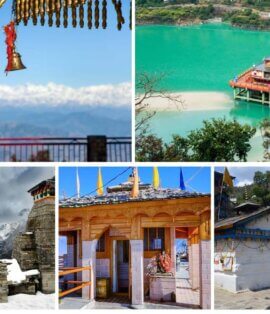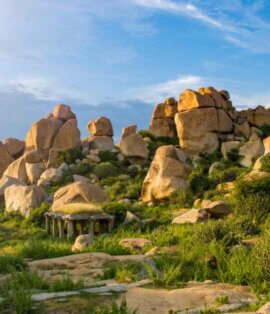Nestled at an altitude of 3,584 meters above sea level on the banks of the Mandakini River, Kedarnath Temple stands as one of the most revered pilgrimage sites in Northern India. The region, historically known as “Kedar Khand,” is home to this sacred shrine, which forms an integral part of both the Char Dham and Panch Kedar pilgrimage circuits in Uttarakhand. It is also honored as one of the 12 Jyotirlingas of Lord Shiva across India.
Chamoli district alone boasts over 200 shrines dedicated to Lord Shiva, with Kedarnath being the most significant. According to legend, after emerging victorious in the Kurukshetra war, the Pandavas sought Lord Shiva’s blessings to absolve their sins. Shiva, avoiding them, disguised himself as a buffalo and fled to Kedarnath. When the Pandavas pursued him, he dived into the ground, leaving his hump visible above the surface — now worshipped at the temple.
The remaining parts of Shiva’s body surfaced at four other locations, forming the sacred Panch Kedar: Tungnath (arms), Rudranath (face), Madmaheshwar (belly), and Kalpeshwar (hair and head).
The temple, surrounded by majestic snow-clad peaks, is a stunning sight. Originally constructed in the 8th century A.D. by Jagad Guru Adi Shankaracharya, it stands beside an even older temple built by the Pandavas. Built from massive grey stone slabs, the temple’s assembly hall features intricate carvings of deities and mythological scenes, with a majestic statue of Nandi the bull guarding the entrance. Inside, the sanctum houses a conical rock representing Shiva’s Sadashiva form.
History
Kedarnath holds a profound place in Hindu tradition as the highest among the twelve Jyotirlingas, manifestations of Lord Shiva as cosmic light. This ancient temple, dating back over a millennium, stands in the Rudra Himalaya range and requires a 16-kilometer trek from Gaurikund.
Built from enormous stone slabs atop a vast platform, the temple’s sanctum walls are adorned with intricate mythological carvings, and Pali inscriptions grace its steps. According to the Mahabharata, the Pandavas constructed the original temple after seeking Shiva’s forgiveness for their wartime sins.
In winter, Kedarnath faces heavy snowfall, covering the temple under meters of snow. Each November, priests carry the symbolic statue of Lord Shiva down to Ukhimath for worship, returning it in May for the temple’s reopening. Pilgrims from across India flock to Kedarnath during the open season, typically from May to October.
Weather and Climate
- Winter (October to April): Winters are freezing, with temperatures plunging below zero and heavy snowfall common. Travel is not advisable during this time.
- Summer (May to June): Summers are mild and pleasant, making it the ideal time for sightseeing and pilgrimage.
- Monsoon (July to mid-September): Monsoons bring heavy rains and the risk of landslides, often making travel difficult.
Thus, the best time to visit Kedarnath is from May to early July and from mid-September to October, before the onset of winter.
How to Reach Kedarnath
- By Flight: The nearest airport is Jolly Grant Airport (near Dehradun), located about 235 kilometers from Kedarnath. From the airport, taxis can take you to Gaurikund.
- By Train: The nearest railway station is Rishikesh, approximately 243 kilometers away. Regular trains connect Rishikesh to major Indian cities, and taxis or buses are available to Gaurikund.
- By Road: Gaurikund is well connected by motorable roads to cities like Haridwar, Rishikesh, Dehradun, and Srinagar. Buses and taxis are easily available.
From Gaurikund, pilgrims must trek approximately 16 kilometers to reach Kedarnath Temple. Helicopter services are also available for a quicker journey.
Accommodations
Pilgrims visiting Kedarnath can choose from several accommodation options:
- Dharamshalas: Affordable lodgings run by various organizations.
- Nearby Hotels: Private hotels at Sitapur (near Sonprayag), about 20 km from Kedarnath.
- BKTC Guest Houses: Available at Sonprayag and Guptkashi, offering comfortable stays for pilgrims.
Many pilgrims opt to stay at nearby locations and complete their Kedarnath darshan in a single day via pony rides or helicopter services.
Nobility and Spiritual Significance
According to the Skanda Purana, Lord Shiva himself declared the ancient Kedar region as sacred, having taken the divine form of Brahma here to initiate the creation of the universe. Because of this, Kedarnath holds immense spiritual significance, seen as a heavenly abode on Earth.
Among the twelve Jyotirlingas, Kedarnath (referred to as Sri Kedar Ekadash) stands paramount due to its high Himalayan location. It is believed that the Pandavas built the temple after the events of the Mahabharata, creating a grand architectural marvel over 80 feet high, shaped quadrangularly and featuring finely carved local stones.
Inside the Garbha Griha, the self-manifested (Swayambhu) Jyotirlinga of Lord Shiva exists as a conical rock. Nearby statues of Parvati, Krishna, the five Pandavas, and Kunti Devi adorn the Sabha Mandap (assembly hall). At the main gate, stone sculptures of Ganesha and Nandi welcome devotees, while the Amrit Kund and a statue of Bhairavnath ji along the Parikrama Path (circumambulatory path) add to the sanctity of the temple complex.






